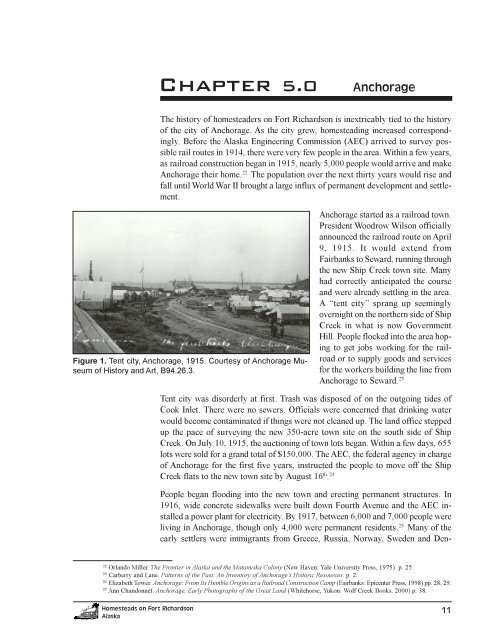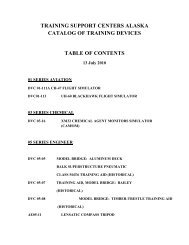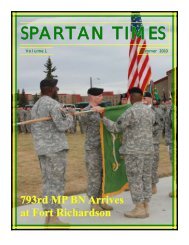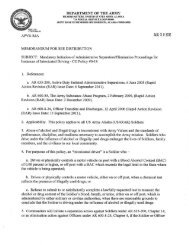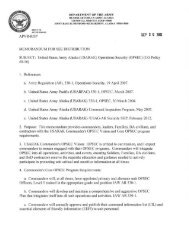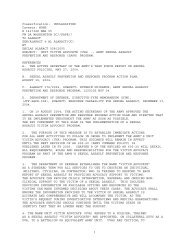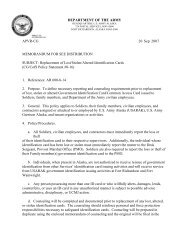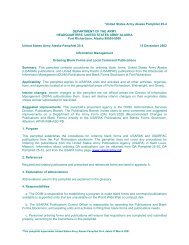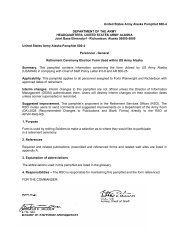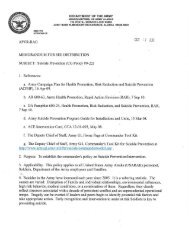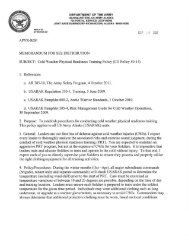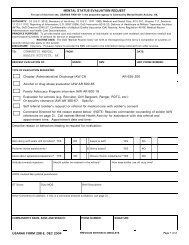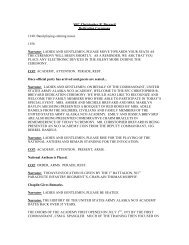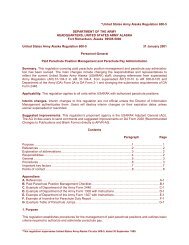Homesteads on Fort Richardson, Alaska - The USARAK Home Page ...
Homesteads on Fort Richardson, Alaska - The USARAK Home Page ...
Homesteads on Fort Richardson, Alaska - The USARAK Home Page ...
- No tags were found...
Create successful ePaper yourself
Turn your PDF publications into a flip-book with our unique Google optimized e-Paper software.
Chapter 5.0Anchorage<strong>The</strong> history of homesteaders <strong>on</strong> <strong>Fort</strong> Richards<strong>on</strong> is inextricably tied to the historyof the city of Anchorage. As the city grew, homesteading increased corresp<strong>on</strong>dingly.Before the <strong>Alaska</strong> Engineering Commissi<strong>on</strong> (AEC) arrived to survey possiblerail routes in 1914, there were very few people in the area. Within a few years,as railroad c<strong>on</strong>structi<strong>on</strong> began in 1915, nearly 5,000 people would arrive and makeAnchorage their home. 22 <strong>The</strong> populati<strong>on</strong> over the next thirty years would rise andfall until World War II brought a large influx of permanent development and settlement.Figure 1. Tent city, Anchorage, 1915. Courtesy of Anchorage Museumof History and Art, B94.26.3.Anchorage started as a railroad town.President Woodrow Wils<strong>on</strong> officiallyannounced the railroad route <strong>on</strong> April9, 1915. It would extend fromFairbanks to Seward, running throughthe new Ship Creek town site. Manyhad correctly anticipated the courseand were already settling in the area.A “tent city” sprang up seeminglyovernight <strong>on</strong> the northern side of ShipCreek in what is now GovernmentHill. People flocked into the area hopingto get jobs working for the railroador to supply goods and servicesfor the workers building the line fromAnchorage to Seward. 23Tent city was disorderly at first. Trash was disposed of <strong>on</strong> the outgoing tides ofCook Inlet. <strong>The</strong>re were no sewers. Officials were c<strong>on</strong>cerned that drinking waterwould become c<strong>on</strong>taminated if things were not cleaned up. <strong>The</strong> land office steppedup the pace of surveying the new 350-acre town site <strong>on</strong> the south side of ShipCreek. On July 10, 1915, the aucti<strong>on</strong>ing of town lots began. Within a few days, 655lots were sold for a grand total of $150,000. <strong>The</strong> AEC, the federal agency in chargeof Anchorage for the first five years, instructed the people to move off the ShipCreek flats to the new town site by August 16 th . 24People began flooding into the new town and erecting permanent structures. In1916, wide c<strong>on</strong>crete sidewalks were built down Fourth Avenue and the AEC installeda power plant for electricity. By 1917, between 6,000 and 7,000 people wereliving in Anchorage, though <strong>on</strong>ly 4,000 were permanent residents. 25 Many of theearly settlers were immigrants from Greece, Russia, Norway, Sweden and Den-22Orlando Miller. <strong>The</strong> Fr<strong>on</strong>tier in <strong>Alaska</strong> and the Matanuska Col<strong>on</strong>y (New Haven: Yale University Press, 1975) p. 25.23Carberry and Lane. Patterns of the Past: An Inventory of Anchorage’s Historic Resources. p. 2.24Elizabeth Tower. Anchorage: From Its Humble Origins as a Railroad C<strong>on</strong>structi<strong>on</strong> Camp (Fairbanks: Epicenter Press, 1998) pp. 28, 29.25Ann Chand<strong>on</strong>net. Anchorage, Early Photographs of the Great Land (Whitehorse, Yuk<strong>on</strong>: Wolf Creek Books, 2000) p. 38.<str<strong>on</strong>g><strong>Home</strong>steads</str<strong>on</strong>g> <strong>on</strong> <strong>Fort</strong> Richards<strong>on</strong><strong>Alaska</strong>11


